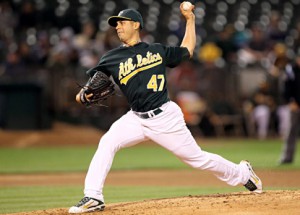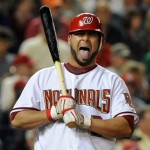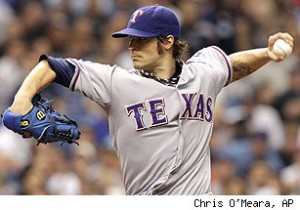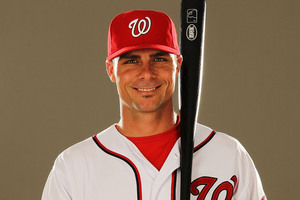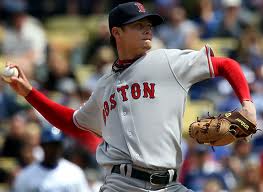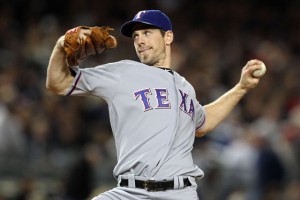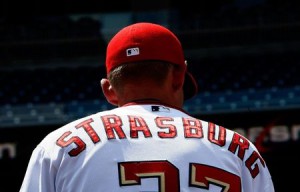
Remember this guy? He’ll be 100% for next spring and may spell a changing of the guard in the division. Photo via AllansGraphics.com
With major moves being made this off-season for the rotations of the NL East teams, we seem set to be in store for some serious pitching duels intradivision in 2012. How do the rotations stack up, right now? If the season started tomorrow, here’s what we’d be looking at for rotations:
| Philadelphia | Atlanta | Miami | Washington | New York | |
| #1 | Halladay | Hudson | Johnson | Strasburg | Santana? |
| #2 | Lee | Jurrjens | Buehrle | Gonzalez | Dickey |
| #3 | Hamels | Hanson | Sanchez | Zimmermann | Pelfrey |
| #4 | Worley | Beachy | Nolasco | Jackson | Niese |
| #5 | Pineiro | Delgado | Zambrano | Wang | Gee |
| In the mix | Blanton, Kendrick, Willis? | Minor, Teheran | Vazquez?Volstad, LeBlanc | Lannan, Detwiler, Gorzelanny | Young? Schwinden? |
By team, some observations:
- Philadelphia plans on replacing Roy Oswalt‘s 2011 starts with a call-up who looked pretty good last year in Worley. Joe Blanton looks like the odd-man out and his $8.5M salary may be wasted by virtue of an underrated but saavy acquisition of Joel Pineiro. The Oswalt trade didn’t give the team what it seeked (a World Series title) but it didn’t cost them a ton in prospects either (JA Happ didn’t exactly light it up for Houston). They’ve signed Dontrelle Willis for rotation depth. Still, you can’t argue with three Cy Young candidates at the top of your rotation, and this team remains the team to beat in the division despite injuries (Ryan Howard) and aging (every single projected starter not named Hunter Pence is 30 or older, and Pence will be 29). The pitching staff was #1 in ERA in the NL and I can’t imagine them dropping far from that. If Worley performs like he did in 2011, and if Pineiro returns to his St. Louis form, then this is just as tough a 1-5 as last year.
- Atlanta should have won the wild card last year and seems set to roll out a rather similar rotation this year. They’ll replace their worst starter Derek Lowe with starts from one of three up-and-coming rookies (I’ve got Delgado slated there now but likely Mike Minor wins the #5 spot in spring training) and should be improved. Hudson is a year older and hasn’t missed a start in 2 years, but is slow coming back from off-season back surgery and may or may not be ready for opeing day. The staff was #4 in the NL in team ERA and should do nothing but improve … but there’s some serious injury question marks. Their incredible SP minor league depth should get them through.
- Miami has a some major question marks, despite acquiring Mark Buehrle to slot into their #2 spot. They will cross their fingers on Josh Johnson; if he’s not healthy this team will be really hurt. Nolasco can be brilliant or awful from start to start. We still don’t know if Vazquez is retiring or returning; my initial guess would have been that he was too good in 2011 (3.69 era, 106 era+) and too young (reportedly 34 but i’ve never heard of any age-questioning here) to retire. To provide cover though, the team traded for the volatile but possibly still talented Carlos Zambrano to slot in at #5. Which Zambrano will they get? And will his notorious clubhouse antics gibe with new hot-head manager Ozzie Guillen? On paper, a 1-5 of Johnson, Buehrle, Nolasco, Sanchez and Zambrano spells an awful lot of power and a lot of Ks. They could be tough. They should improve on last year’s #10 team ERA ranking.
- Washington just got a lot better, replacing 29 mostly awful Livan Hernandez starts with a healthy Stephen Strasburg and likewise replacing 35 combined mediocre starts out of Jason Marquis and Tom Gorzelanny with newly acquired power lefty Gio Gonzalez and power righty Edwin Jackson. They were 6th in the NL in team ERA, have mostly the same bullpen in place (5th best in the league in ERA in 2011) and seem set to improve. Chien-Ming Wang seems set for the #5 spot, leaving John Lannan potentially being the most expensive pitcher in Syracuse. The jeopardy the team now has is an utter lack of starting pitching depth; Peacock and Milone WERE our 2012 rotational safety nets; now we have just Detwiler, Gorzelanny and a couple guys who clearly seem to be AAA starters. For this reason the team probably keeps Lannan around with the eventual goal of having him provide cover until our next wave of high-end pitching prospects develop. Either way, this rotation and bullpen look to be improved from 2011.
- New York faces a grim 2012, not only in the rotation but also in the front office. We’re hearing reports that Johan Santana is still too hurt to make opening day (though he’s since spelled some of these concerns with his first spring training outing). Converted knuckleballer R.A. Dickey spent his off-season in a nasty fight with management over his charity climb of Mt. Kilimanjaro. All their other starters posted ERAs in the mid to upper 4’s (or worse) with ERA+ figures in the 78-82 range. And there doesn’t seem to be help coming on the Free Agency front (since the team can’t afford to keep operations running without bank loans) or on the prospect front (a quick glance at their AAA and AA starting talent resulted in ONE starter who had a minor league era in the respectable range, an 18th rounder in AA). I think this team is finishing dead last in 2012 and may lose 100 games despite their payroll. And to add insult to injury, the owners were just forced to cough up $83 million in a pre-trial settlement over their Madhoff scandal involvement. Tough times are ahead for the Mets.
What do you guys think? In terms of Washington, more than a few pundits have stated that the addition of Gonzalez makes the Nats a wild card contender, right now, and that was before the Jackson move finally brought some plaudits from typically cynical national baseball writers when considering signings by this franchise.
Do you think the Nats have now supplanted the Braves as having the 2nd best rotation in the division (as ESPN’s Buster Olney is opining?) I think they have; I think Atlanta’s starters may be taking a slight step back while our quintet looks to be a solid, young but relatively experienced core.
